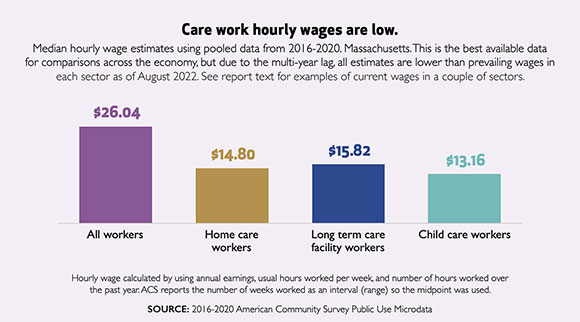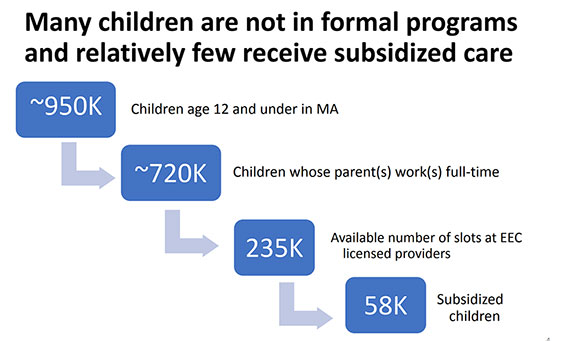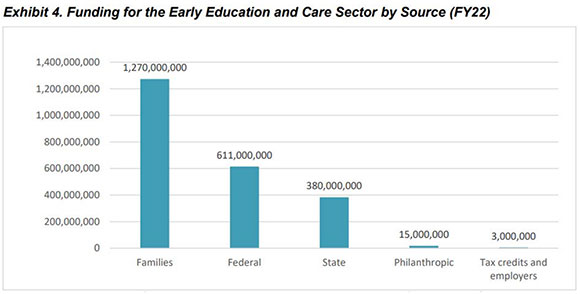(The opinions and views expressed in the commentaries and letters to the Editor of The Somerville Times belong solely to the authors and do not reflect the views or opinions of The Somerville Times, its staff or publishers)

By State Senator Pat Jehlen
On March 14, the Massachusetts Senate unanimously passed the EARLY ED bill, to increase support for early education and care (EEC). We recognized the importance of quality EEC for children, for families, and for businesses and the economy.
WHAT THE BILL DOES
The bill will:
– make the Commonwealth Cares for Children (C3) grants program permanent
These monthly payments, initially from federal pandemic funds, but now state-funded, have helped keep programs open. reduce tuition costs, improve educator pay, and increase the number of childcare slots. Channel 10 explained the importance of continuing those grants.
– expand eligibility for subsidies
Families up to 85% of the state median income ($124,000 for a family of 4) will be able to receive assistance on a sliding scale.
– cap subsidy recipients’ childcare costs at 7% of family income
– create a career ladder for early educators, and provide scholarships and loan forgiveness.
This all depends on allocations in the state budget, and details depend on regulations, but it’s a statement of the Senate’s intention and values.
Sen. Jason Lewis, Senate chair of the Education Committee, led development of the bill, based on the Special Legislative Early Education and Care Economic Review Commission, which he also co-chaired.
EARLY EDUCATION AND CARE IS EXPENSIVE!
As I wrote last year, Massachusetts is among the most expensive states in the country for early education and care. The average cost for an infant is $21,000; for a toddler it’s $19,000; and for a pre-schooler it’s $15,000. Many families pay 20-40% of their income for care.
YET EDUCATORS ARE UNDERPAID
Early educators’ average salary in Massachusetts in 2022 was $39,000. Those with a BA earn 43% less than comparable public school teachers, according to the Special Legislative Early Education and Care Economic Review Commission.
The EEC workforce is 92% women and 41% women of color. Even compared to other care workers, also mostly women and people of color, early educators are underpaid, the Boston Foundation reported in 2022. This graph from their report shows years before the minimum wage rose to $15/hour, but the comparison is still instructive.

A report this year calculated how much it takes to pay for food, housing, health care, transportation, taxes, etc. in Middlesex County.

MANY CENTERS HAVE CLOSED OR REDUCED SLOTS
During the pandemic, close to 20% of the child care programs in Massachusetts closed. Many still remain closed or are unable to hire enough staff to re-open rooms.
The Boston Foundation reported that “As of 2021, Massachusetts had almost 5,000 fewer early educators, on average, than before the pandemic. Fewer early educators means that programs have to close classrooms. Statewide, the proportion of center-based providers unable to serve their full capacity has increased from 28 to 35 percent since the spring of 2022 and family child care (FCC) capacity remains below pre-pandemic levels.”
WHO PAYS FOR EARLY EDUCATION AND CARE?
The following chart, from the Special Legislative Commission, includes children age 12 and under, because the EEC Department serves not only preschool children, but those in out of school time programs (as well as other programs).

EEC is mostly paid for by families, with the state supporting about 1/6 of the total cost.

The Special Legislative Early Education and Care Economic Review Commission, the source of the last two charts, estimated that fully funding its recommendations would cost an additional $1.5 billion/year over time, and expressed hope that the federal government would be a major source.
The EARLY ED bill did not have a fiscal note or cost estimate. For information on budgets, including trends in early education funding and Gov. Healey’s proposal, always look at Mass Budget. However, the trends page doesn’t include the federal funding that increased spending during the pandemic and has now ended.
General revenues this year are essentially flat, which means a very constrained budget. We should be grateful to everyone who worked and voted for the Fair Share Amendment in 2022! Thanks to the 4% surtax on incomes over $1 million, we will be able to spend $1.3 billion above general revenues on education and transportation. That’s an increase of $300 million over the FY24 budget.
WE CAN DO BETTER!
Many countries give much more support to families. Here’s a chart showing what child care costs as a share of a woman’s full-time income.
Florida, Georgia, Oklahoma, and the District of Columbia currently make free pre-K available to all four-year-olds, and Vermont makes it available to 3-year-olds.
The Globe reports this week that free child care was funded during World War II as part of national defense, since it allowed women to go to work.
AZERBAIJAN DID BETTER
The most dramatic comparison I’ve seen was offered by my neighbor Illona Yukhayev in testimony to the Education Committee. She compared her experience as a child in Azerbaijan when it was part of the Soviet Union, to her children’s experience in the US. It’s 3 minutes at minute 52 in this hearing. It’s worth watching.
GRATITUDE!
One example of quality early education is the Open Center for Children, where our son Nick was one of the first students. (Here he is listening to a teacher.) More recently, our granddaughters Anika and Kayala also thrived there. Our children and grandchildren were also lucky to attend wonderful family child care and public school programs. I’m so grateful for all the amazing educators that give young people a great start!
Happy spring!
















Reader Comments